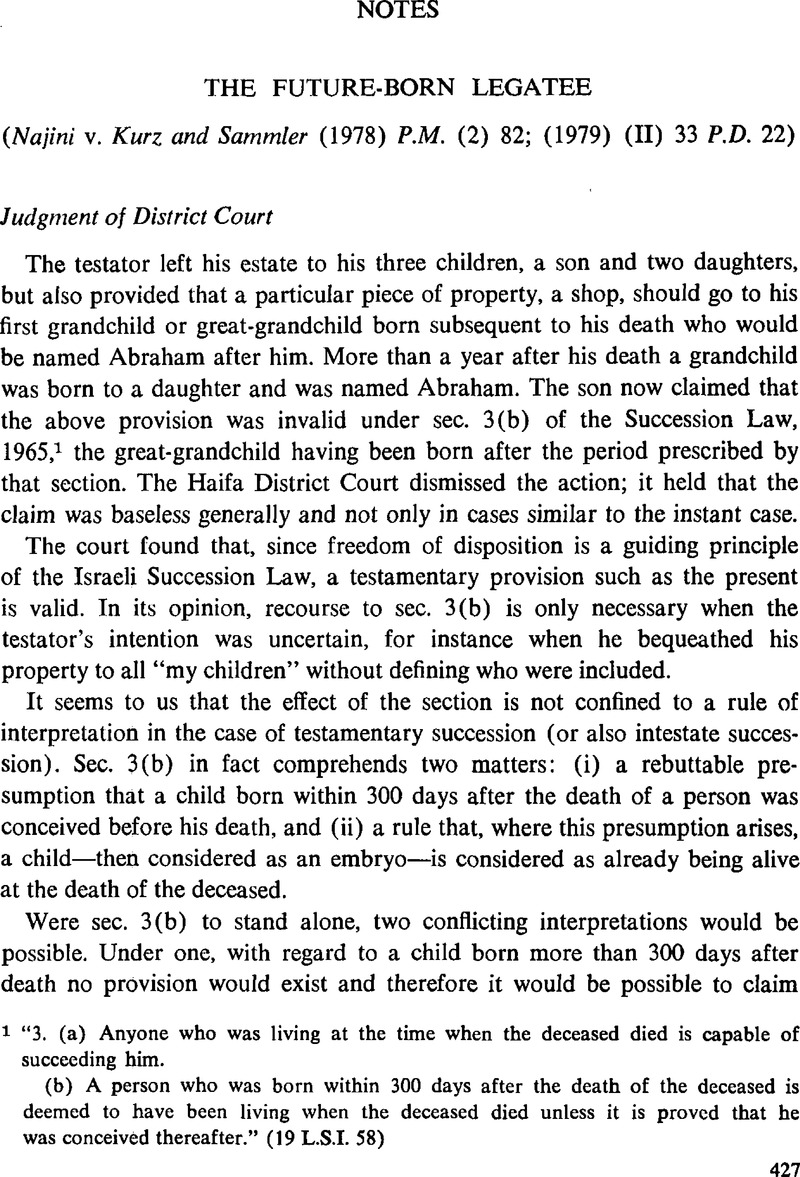No CrossRef data available.
Published online by Cambridge University Press: 12 February 2016

1 “3. (a) Anyone who was living at the time when the deceased died is capable of succeeding him.
(b) A person who was born within 300 days after the death of the deceased is deemed to have been living when the deceased died unless it is proved that he was conceived thereafter.” (19 L.S.I. 58)
2 Ministry of Justice, Proposal for a Succession Law, 1952, pp. 41–2.Google Scholar
3 “42. (a) The testator may make a bequest to two persons to the effect that the second shall take after the first; the second takes upon the death of the first or upon fulfilment of the condition, or at the time fixed therefor in the will, whichever is the earlier.
(b) The first heir may deal with what he has received as his own and the second shall only take what the first has left, provided that the first cannot curtail the rights of the second by means of a will.
(c) The second heir shall take if he is capable of succeeding the testator when his right matures, notwithstanding that he was not capable to do so at the death of the testator; if the second dies before his right matures or is found disqualified to succeed or renounces what is due to him, the testamentary provision in his favour becomes void.
(d) A testamentary provision in this manner in favour of more than two persons is void save in so far as it is in favour of a person alive at the time when the will was made”.
4 Proposal for a Succession Law, 1952, cit., p. 88.
5 Lavie v. Yaffe (1976) (II) 30 P.D. 188.
6 Cf. Greiber v. Greiber (1975) (II) 29 P.D. 673.
7 Cf. secs. 2, 131(a) and 51(b)-(c).
8 The same applies where a “successive heirs” provision is invalid as regards the first heir and not the second, or where the first waives his interest (renounces it, in the terms of sec. 6).
9 Cf. §§ 2101 and 2105 of the BGB; sec. 545 (second paragraph) of the Swiss Civil Code.
10 “43. (a) The testator may direct in his will that an heir shall take upon the fulfilment of a condition or at a certain time.
(b) If the condition is not fulfilled or the time has not arrived before the death of the testator, the estate shall be administered by an administrator until the condition is fulfiled or the time arrives or until it becomes clear that the condition can no longer be fulfilled; the same shall apply where the testator makes a bequest to an association which is not yet capable of inheriting in accordance with section 4.
(c) Where the testator has not designated who shall take when it becomes clear that the condition can no longer be fulfilled, those who succeed on intestacy shall take.”
11 Another case of a testamentary provision in favour of one person requiring that another should first take (either under the will or on intestacy) in order to be valid may be found in legacies. Indeed, in our opinion, the legatee is comprehended among the heirs referred to in sec. 1 of the Law—and therefore, if the testator gave a particular asset of the estate to the legatee, the latter will succeed immediately and directly upon the testaor's deah (without passing through the general heirs). If, however, the property is designated by class alone (such as one of the testator's Persian carpets) or is a matter of election, ownership will pass upon the property being separately ascertained or upon election and until then ownership must necessarily lie in the general heirs to avoid the legacy failing.
12 Inzel v. Kugelmas (1975) (I) 29 P.D. 663, 665.
13 See the title “Nascituro (Storia)” in Enciclop. del diritto. XXVII, pp. 535, 537. See also Stolfi, , “I nascituri non concepiti”, Annali U niv. Macerata, VI (1930) 109et seq.Google Scholar; Planiol, , Traité élém. de droit civil. III (10th ed., 1927) No. 1709, p. 379Google Scholar; Ripert, and Boulanger, , Traité de droit civil, IV (1959) No. 3405 et seq., p. 1086.Google Scholar
14 See e.g. the Italian Civil Code of 1865, sec. 764. The Italian Code of 1942 (secs. 462 and 692) retains such a provision and permits the appointment of successive heirs in another area.
15 See e.g. the Swiss Civil Code, sec. 488 (one substitution), the Austrian Civil Code, secs. 611–12 (one substitution in the case of land and two in the case of movable property).
16 See e.g. BGB, § 2109 (30 years—which is regarded as the average period of survival of a generation—with some exceptions).
17 See e.g. the French Civil Code, secs. 896, 897, 1048–74. French lawyers tend to exclude certain cases from the prohibition, among them fideicommissum de residuo. This is held to be valid even if it goes to future-born persons: Dalloz, , Encyclop., Droit Civil, 2 ed. (1977) IV, “Substitution” No. 37 et seq.Google Scholar; Mazeaud, , Leçons de droit civil, 2 ed., IV, No. 1435.Google Scholar
18 See the criticism of English rule with regard to its practical consequences in Arminjon, , Nolde, , Wolff, , Traité de droit comparé, III (Paris, 1951), para. 771, p. 43.Google Scholar
19 See Ripert and Boulanger, op. cit., No. 3865, p. 1226.